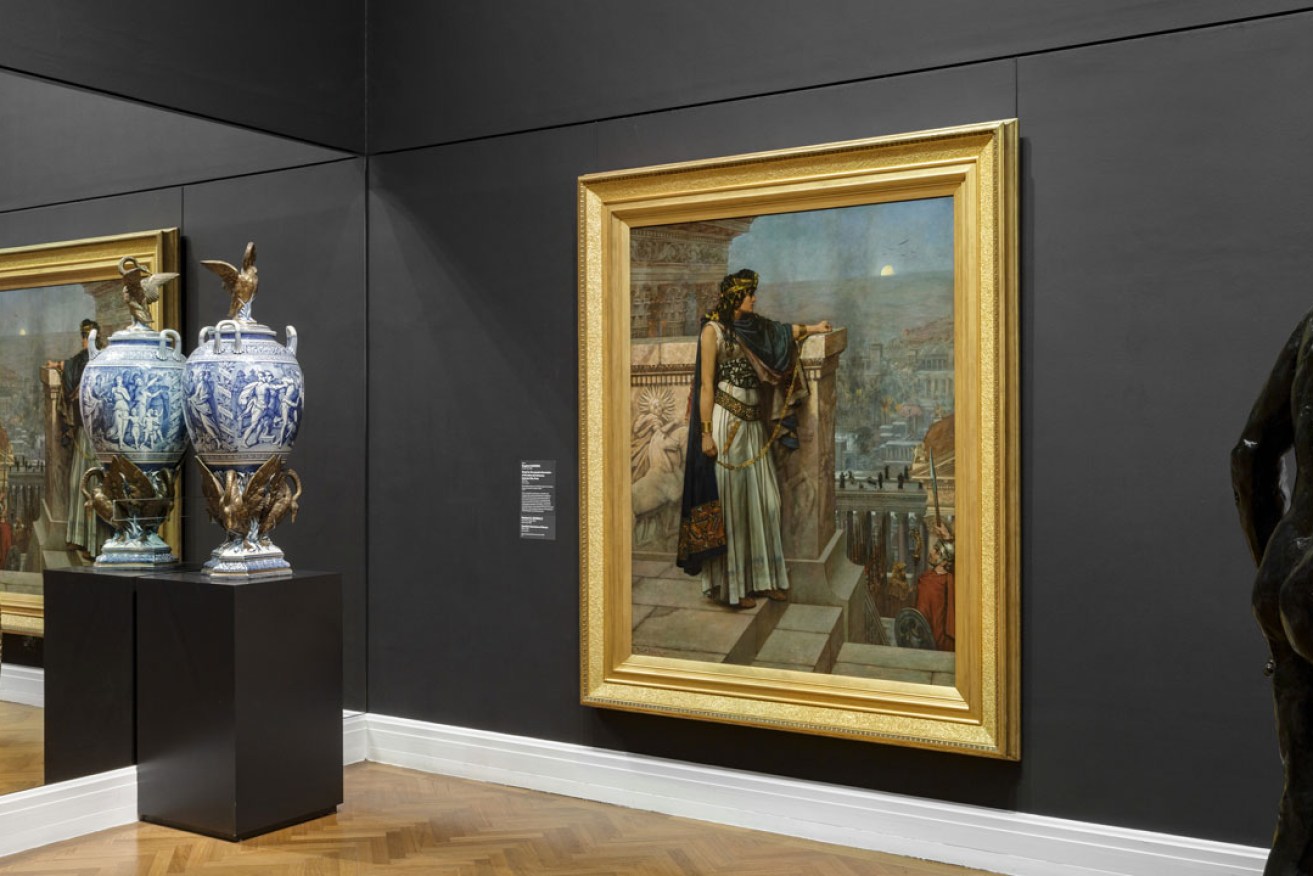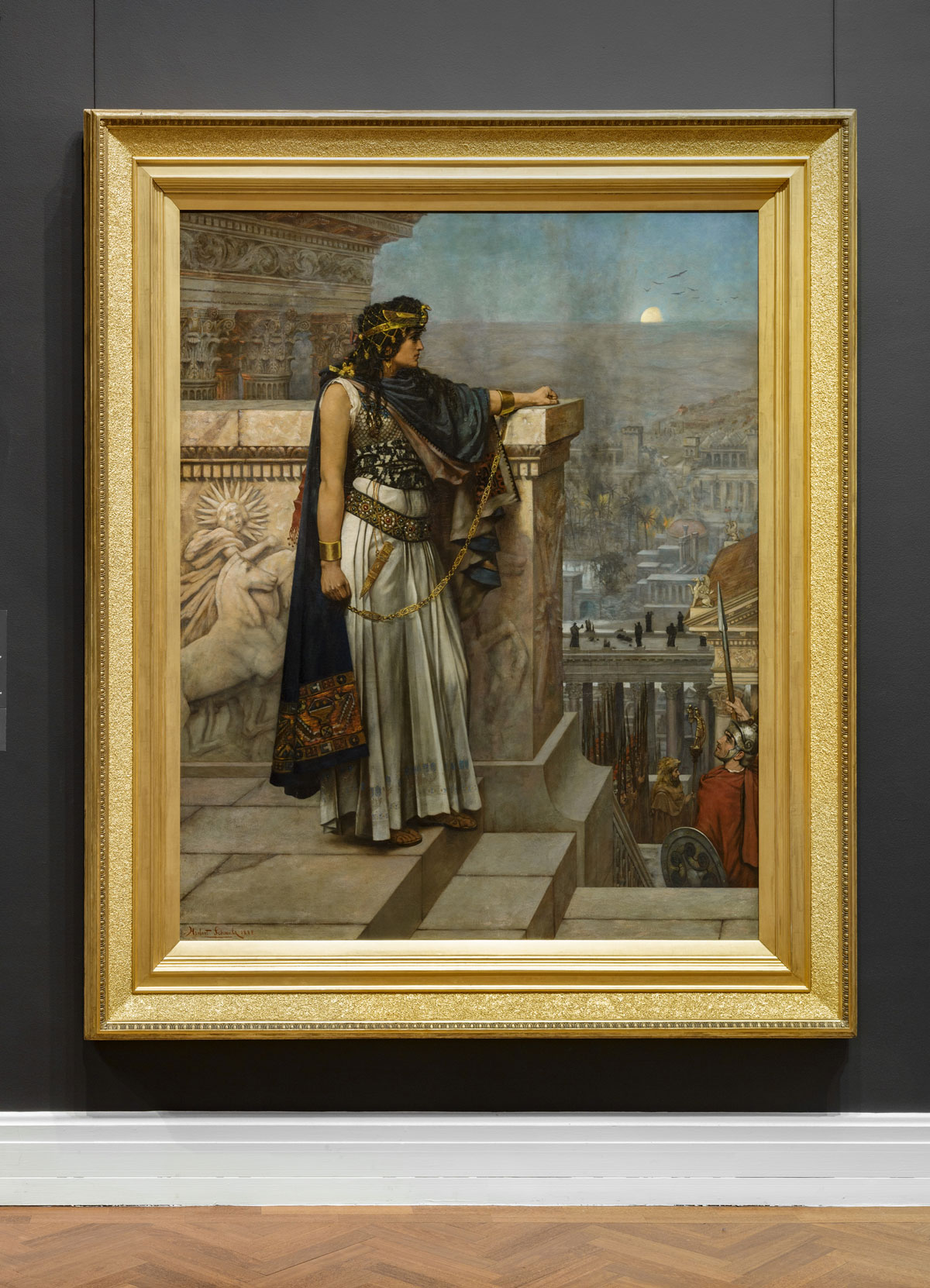The surprising radical past of one of Adelaide’s favourite paintings
OFF THE WALL: The AGSA’s Lisa Slade uncovers the lesser-known story behind one of Adelaide’s favourite paintings – a monumental work that inspired late 19th-century SA suffragettes and still provides inspiration to women living in the Middle East today.

Zenobia's last look on Palmyra, by Herbert G Schmalz, in Gallery 12 of the AGSA's Melrose Wing. Photo: Saul Steed
The first work to enter the Art Gallery of SA’s collection, and arguably South Australia’s most-loved painting, is HJ Johnstone’s Evening shadows, backwater of the Murray, South Australia, 1880.
Copied by admirers and budding artists alike, Evening shadows has ensured its place in art history and the popular imagination via the myriad versions of the painting found hanging on the walls of South Australian homes (or tucked away in back sheds).
Contemporary artist Tom Nicholson recently reprised his 2012 Adelaide Biennial of Australian Art project by gathering as many copies of the painting as he could and hanging them alongside the original – this time at the Australian Centre for Contemporary Art (ACCA) in Melbourne. One hundred and forty years on, it’s hard to know what the painter HJ Johnstone would have made of this move, but given the number of versions Johnstone made of the painting himself, one can imagine that he would be flattered by the work’s ongoing resonance.
A recent discovery reveals that Evening shadows was not the only painting in the Art Gallery of South Australia’s fledgling 19th-century collection that attracted copyists. Painted in London by Herbert G Schmalz in 1888, Zenobia’s Last Look on Palmyra inspired a legion of South Australian suffragettes in the late 19th century.

Herbert G Schmalz, Britain, 1856‑1935, Zenobia’s last look on Palmyra, 1888, London, oil on canvas, 183.4 x 153.6cm; South Australian Government Grant 1890, Art Gallery of SA. Photo: Saul Steed
Monumental in both impact and scale (measuring in its neo-classical frame at more than two metres high and almost two metres across), the oil painting depicts Zenobia, the defeated warrior-queen, watching the sun set on the eastern Roman empire and the Syrian city of Palmyra in the year 272.
South Australian artist and suffragette Amy Bosworth was drawn to the painting and its star subject Zenobia – an emblem of female power and stoicism in the late 19th century. Bosworth was born in Riverton in 1872 and studied at the Adelaide School of Design under HP Gill, who was appointed honorary curator of the Gallery in 1892.
In that same year, Bosworth made a convincing and technically-astute copy of Schmalz’s painting. Today it is held in Qatar’s national collection in Doha and was recently included in the Syria Matters exhibition at the Museum of Islamic Art, where it was seen by one of the Gallery’s key supporters who shared the sighting back in Adelaide, spurring subsequent research.
More than 125 years later, Zenobia’s Last Look on Palmyra provides inspiration to women living in the Middle East today.
In addition to Bosworth’s painting, Zenobia inspired dozens of letters to the editor, written by South Australian women, which appeared in the South Australian Register in the late 19th century. Each letter carried the nom de plume Zenobia and advocated for the rights of girls and women in education and in public life more broadly.
Zenobia as a nom de plume (or perhaps more appropriately a nom de guerre) protected the identities of the young radicals and also offered a 19th-century proto-meme of solidarity and resistance.
Currently on display in Gallery 12 of the Melrose Wing at the Art Gallery of South Australia, Schmalz’s Zenobia’s Last Look on Palmyra offers not only a surprising link to South Australia’s political past but also a reminder of more recent global events including the seizure of Palmyra in 2015 by ISIS, who launched a campaign of cultural destruction against the ancient city. The Corinthian colonnade (visible in the painting), which featured dedications to Zenobia, was severely damaged in the conflict.
The 125th anniversary of women’s suffrage in South Australia is upon us and the recent recovery of this painting’s radical past is a timely reminder that history is continuously rewritten in the present and that the challenges, conflicts and conquests of yesterday hold critical currency today.
A selection of letters to the editor that appeared in the South Australian Register between 1888 and 1891 above the nom de plume “Zenobia” (Queen of Palmyra) can be viewed here.
Postscript: Ny Carlsberg Glyptotek art museum in Copenhagen, Denmark, has recently requested from the AGSA a large-scale reproduction of Zenobia’s Last Look on Palmyra by Herbert G Schmalz for its exhibition titled The Road to Palmyra.
Dr Lisa Slade is assistant director, artistic programs, at the Art Gallery of South Australia.




